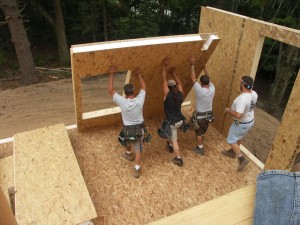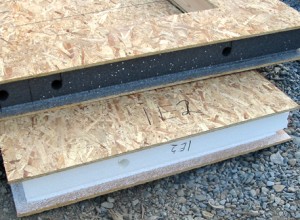Installment 1: SIPs Construction
October 11th, 2010

What are SIPs?

The advantages of SIP construction include:
Superior Energy Efficiency
Heating and cooling account for the largest part of most families’ energy use. The Insulspan SIP System provides tighter, more efficient building shell that works with building components like high-efficiency windows and doors to reduce heat loss from 30 to 50 percent over stick-framed construction. Here’s why:
- SIPs’ higher R-value keeps conditioned air in. The R-value of a wall or roof is a measure of its ability to keep heat from flowing through it. Higher R-value for walls and roof means less heat loss and less energy used for heating and cooling.
- Fewer wooden studs mean less thermal bridging. “Thermal bridging” occurs when insulation is interrupted. In traditional construction the most common break is caused by studs, which not only create uninsulated areas in the wall, but act as thermal bridges between the exterior of the building and the finished interior. Fewer thermal bridges mean SIPs provide a higher effective R-value than stick-framed construction.
- Solid wall and roof spans prevent air-infiltration. In stick-framed construction, the void between batt insulation and wood studs increase air leakage, increasing heat loss no matter how much batt insulation is used. Air leakage results in increased energy loss, drafts, and inconsistent indoor temperatures. This reduced air movement also virtually eliminates the infiltration airborne pollutants and moisture and, leaving no place for condensation to collect.
Speed of construction
A 2006 RSMeans Time & Motion Study comparing the construction of a SIP house to an identical house using stick-frame construction found that using SIPs reduced installation time by 130 labor hours. This is equivalent to a time savings of approximately 55 percent over the conventionally framed home. Rough-wiring in the SIPs walls took 89% of the labor hours expected for rough wiring in a conventional house. Other advantages noted by the study: SIPs eliminate the need to install exterior sheathing, thermal insulation, and housewrap separately, and pre-cut door and window openings mean no time is lost to framing rough openings on the jobsite.
Easier EnergyStar and HERS ratings
Structures built with Insulspan SIP wall and roof panels are considered so tight, they can qualify for an Energy Star rating without a blower door test – just a visual inspection form filled out by a HERS rater. SIPs’ energy efficient attributes are also recognized under the ICC 700-2008, the National Green Building Standard developed by National Association of Home Builders Association and International Code Council, and LEED®, the certification system of the U.S. Green Building Council.
Additional builder benefits:
- Arrives ready to install with your own crew – doesn’t replace carpenters
- Chases in place – easy to install electrical, plumbing and HVAC
- Efficient site process integrates with trades
- Easier to drywall – no shrinkage, no nail pops
- Desirable product makes you stand out to buyers
- Positions you as an innovator & provider of good value
- Fewer callbacks
- Faster dry-in
- Eco-friendly product
- No framing waste
